Mining operations
The port of Bilbao was first mined by the Velasco destroyer, early in the morning on 24th September 1936. They laid a total of 40 mines between Punta Galea and Punta Lucero. The aim was to close the entrance to Bilbao to the Republican fleet, which were then making their way northwards from the Mediterranean. The Viscaya Defence Board mobilized a pair of trawlers, the Danak Ondo and the Marce, to act as a minesweeper. The minefield was discovered on the 24th itself and the Basque minesweepers soon opened up a channel, which meant the Fleet was able to enter the port on 26th without problem.
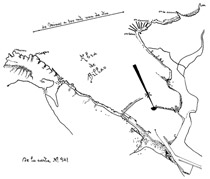 The second attempt to mine Bilbao failed when on the night of the 7th to 8th January, the trawler Nabarra surprised the Velasco and Genoveva Fierro before starting the operation. They returned on the night from the 15th to 16th, and that time managed to lay the 97 mines on the Genoveva and 50 anti-sweeping devices from the Velasco. A barrier was thus formed than began 2 miles to the East of Castro and extended NE to near to Cabo Villano. This time, the mines caused the sinking of the Goizeko-Izarra patrol boat and the Mary-Toya minesweeper, where a total of 23 lives were lost. In the successive months, mines were laid on two further occasions, but without any success. Other mine fields were installed outside Santander, Gijón and Avilés, but the only “success” was the sinking of España, the Franco battleship, off Santander (30-4-37).
The second attempt to mine Bilbao failed when on the night of the 7th to 8th January, the trawler Nabarra surprised the Velasco and Genoveva Fierro before starting the operation. They returned on the night from the 15th to 16th, and that time managed to lay the 97 mines on the Genoveva and 50 anti-sweeping devices from the Velasco. A barrier was thus formed than began 2 miles to the East of Castro and extended NE to near to Cabo Villano. This time, the mines caused the sinking of the Goizeko-Izarra patrol boat and the Mary-Toya minesweeper, where a total of 23 lives were lost. In the successive months, mines were laid on two further occasions, but without any success. Other mine fields were installed outside Santander, Gijón and Avilés, but the only “success” was the sinking of España, the Franco battleship, off Santander (30-4-37).
Two types of mines were laid by the rebels off Bilbao. They began by using the classic Vickers H-16-A “cane” mines, a British design from the First World War, but manufactured in Spain under patent. It was a model that was already obsolete and that the English had rejected them due to their poor performance. They were practically totally inefficient and some ships even hit them and they did not explode. The destroyer Velasco, which could transport a total of 60 mines, was used to lay them, along with the minelayer, Júpiter, that could carry up to 264 of these mines.
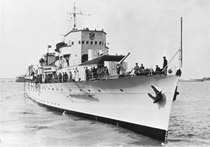 The second type used was the German “horn" mine, EME type, known as “offensive”, which likewise dated back to the First World War, even though it was a more advanced model. It was spherical in shape, with five lead horns on the upper part and was detonated by contact. They were purchased directly from the Germans during the war. The Genoveva Fierro was first fitted out to carry them and could transport up to 100 on the deck rails and a further 100 in the hold. The Júpiter was later adapted for the same task. These were the mines which sank the Goizeko-Izarra, the Mari-Toya and, later on, the battleship España, and they were also a real danger for sailing.
The second type used was the German “horn" mine, EME type, known as “offensive”, which likewise dated back to the First World War, even though it was a more advanced model. It was spherical in shape, with five lead horns on the upper part and was detonated by contact. They were purchased directly from the Germans during the war. The Genoveva Fierro was first fitted out to carry them and could transport up to 100 on the deck rails and a further 100 in the hold. The Júpiter was later adapted for the same task. These were the mines which sank the Goizeko-Izarra, the Mari-Toya and, later on, the battleship España, and they were also a real danger for sailing.
Along with the mines, another type of devices known as anti–sweeping devices and also “squid” mines were laid. Their purpose was to break the sweeping rigs of the minesweepers and thus protected the mined field. They were similar in appearance to the “real” mines, but their shell did not contain an explosive charge and only acted as a floater. The "squid" device, which contained a small TNT charge, was one metre under the floater. When the sweeping cable hooked onto it, it exploded and cut the rig. They were laid by the Velasco and Júpiter, along side the other mines.
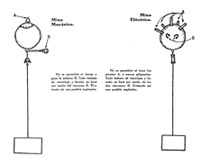 After the fall of Bilbao, Franco’s troops received a new “pear-shaped” model of mine. These “pear-shaped” mines with five horns in the upper part, known as Carbonit type, were built in Germany. Its detonation mechanism was similar to that of the EME type mines. Two fishing boats, the Felisa Rodal and the Rodal Barreiro, were fitted out to lay them. Special tracks were mounted to allow them to each carry four mines. They operated from Ribadeo in July 1937 and laid a total of 32 mines between Gijón and Avilés. They did not score any hits, partly due to that they were few in number. Even though this type of mines were not laid in Basque waters, some Basque minesweepers that were sent to Asturias, after the evacuation of Santander, helped to sweep for them. Two fishing boats, the Felisa Rodal and the Rodal Barreiro, were fitted out to lay them. Special tracks were mounted to allow them to each carry four mines. They operated from Ribadeo in July 1937 and laid a total of 32 mines between Gijón and Avilés. They did not score any hits, partly due to that they were few in number. Even though this type of mines were not laid in Basque waters, some Basque minesweepers that were sent to Asturias, after the evacuation of Santander, helped to sweep for them.
After the fall of Bilbao, Franco’s troops received a new “pear-shaped” model of mine. These “pear-shaped” mines with five horns in the upper part, known as Carbonit type, were built in Germany. Its detonation mechanism was similar to that of the EME type mines. Two fishing boats, the Felisa Rodal and the Rodal Barreiro, were fitted out to lay them. Special tracks were mounted to allow them to each carry four mines. They operated from Ribadeo in July 1937 and laid a total of 32 mines between Gijón and Avilés. They did not score any hits, partly due to that they were few in number. Even though this type of mines were not laid in Basque waters, some Basque minesweepers that were sent to Asturias, after the evacuation of Santander, helped to sweep for them. Two fishing boats, the Felisa Rodal and the Rodal Barreiro, were fitted out to lay them. Special tracks were mounted to allow them to each carry four mines. They operated from Ribadeo in July 1937 and laid a total of 32 mines between Gijón and Avilés. They did not score any hits, partly due to that they were few in number. Even though this type of mines were not laid in Basque waters, some Basque minesweepers that were sent to Asturias, after the evacuation of Santander, helped to sweep for them.
| Port | Barrier | Data | Minelayer | Vickers mines | Mines | Carbonit mines | Anti-sweeping devices mines | Total mines |
|---|---|---|---|---|---|---|---|---|
| BILBAO | Abra | 24-9-36 | VELASCO | 40 | 40 | |||
| AVILES | Port | 13-1-37 | VELASCO | 20 | 29 | 49 | ||
| BILBAO | Castro Urdiales | 16-1-37 | GENOVEVA F. | 97 | 97 | |||
| Castro Urdiales | 16-1-37 | VELASCO | 50 | 50 | ||||
| AVILES | Port | 10-2-37 | VELASCO | 29 | 17 | 46 | ||
| GIJON | El Musel | 10-2-37 | VELASCO | 5 | 5 | |||
| BILBAO | Oriñón | 19-2-37 | VELASCO | 39 | 21 | 60 | ||
| SANTANDER | Port | 1-4-37 | JUPITER | 46 | 25 | 71 | ||
| BILBAO | Punta Galea | 29-4-37 | VELASCO | 60 | 60 | |||
| GIJON | El Musel | 1-5-37 | JUPITER | 52 | 32 | 84 | ||
| SANTANDER | Cabo Mayor | 2-7-37 | JUPITER | 20 | 20 | |||
| Galizano | 2-7-37 | JUPITER | 20 | 20 | ||||
| GIJON | El Musel | 16-7-37 | F. RODAL | 4 | 4 | |||
| GIJON | Cabo Torres | 18-7-37 | F. RODAL | 4 | 4 | |||
| GIJON | Isla S. Lorenzo | 19-7-37 | F. RODAL | 4 | 4 | |||
| AVILES | Avilés-C. Peñas | 24-7-37 | RODAL B. | 4 | 4 | |||
| AVILES | Avilés-C. Peñas | 28-7-37 | F. RODAL | 4 | 4 | |||
| AVILES | Avilés-C.Peñas | 29-7-37 | RODAL B. | 4 | 4 | |||
| AVILES | Cabo Negro | 30-7-37 | RODAL B. | 4 | 4 | |||
| AVILES | NW de C. Peñas | 31-7-37 | F. RODAL | 4 | 4 | |||
| TOTAL MINES LAID | 233 | 195 | 32 | 174 | 634 | |||
Minesweeping
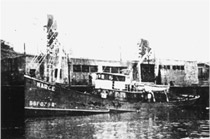 Faced with the mines laid on 16th January, the Republican Cantabrian Sea Naval Forces (Cantabrian Sea is the Spanish name for the Bay of Biscay) assumed control of the minesweeping. Specialists from the Spanish Navy were sent to help and even exploration flights with sea-planes were carried out. The Basque Navy Section helped with a flotilla of minesweepers, along with the necessary personnel and equipment. But after the minesweeper officer died, Ensign Julián Sánchez-Gómez, in the sinking of the Mari-Toya, the Republican Navy was not able to efficiently organize the minesweeping.
Faced with the mines laid on 16th January, the Republican Cantabrian Sea Naval Forces (Cantabrian Sea is the Spanish name for the Bay of Biscay) assumed control of the minesweeping. Specialists from the Spanish Navy were sent to help and even exploration flights with sea-planes were carried out. The Basque Navy Section helped with a flotilla of minesweepers, along with the necessary personnel and equipment. But after the minesweeper officer died, Ensign Julián Sánchez-Gómez, in the sinking of the Mari-Toya, the Republican Navy was not able to efficiently organize the minesweeping.
On 1st February, the Auxiliary Navy decided to take over the task. Captain José María Burgaña was appointed Navy Delegate in Portugalete and was commissioned with organizing the mine recovery services. Burgaña used the same vessels and crew lent to the Republican Navy for these tasks, in total 6 minesweepers (Jaimín, Rafael Cantos, Arco, Iris, Gure Artizar and Gure Izarra) and three auxiliary motor boats (Nazareno nº1, Angel de la Guarda and Nazareno nº9), first under the command of Captain Jesús de Landarte and then, Captain Angel Gabiña. The successive mining of Bilbao meant that the flotilla of minesweepers had to be reinforced. The number of minesweepers was increased to 24 and the auxiliary motor boats to 6 in May. They were all assigned a number preceded by the initial “D” or “L”.
| Barrier | Discovered | Swept | Mine type | Neutralized mines | Total | ||
|---|---|---|---|---|---|---|---|
| Recovered | Exploded | Sank | |||||
| Abra | 24-9-36 | October-36 | Vickers | ? | ? | 40 | |
| Castro | 16-1-37 | 30-3-37 | EME | 20 | 28 | 48 | |
| Anti-sweeping devices | 37 | 37 | |||||
| OriÑon | 25-2-37 | 15-3-37 | Vickers | 10 | 2 | 12 | |
| Anti-sweeping devices | 20 | 20 | |||||
| Pta.Galea | 2-5-37 | 5-5-37 | Vickers | 26 | 17 | 2 | 45 |
| Total neutralized mines | 113 | 47 | 2 | 202 | |||
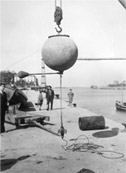 The work of the mine sweepers was to clean the mine fields that obstructed the navigation routes. The procedure was simple: A metal cable or sweep was hung between two minesweepers, which dragged it by the stern, sailing at the same speed and with parallel courses from out of sea towards land. As the vessels moved forward, the sweep would hook on to the cable that kept the mine submerged and pull on it until it was pulled from its anchorage. During this operation, the mine sometimes spontaneously exploded and other times, it rose up to the surface where the crew fired at it to make it explode or it was towed to shore to deactivate it and use the explosives that it contained. On several occasions, the mines sank after the mooring cable was cut.
The work of the mine sweepers was to clean the mine fields that obstructed the navigation routes. The procedure was simple: A metal cable or sweep was hung between two minesweepers, which dragged it by the stern, sailing at the same speed and with parallel courses from out of sea towards land. As the vessels moved forward, the sweep would hook on to the cable that kept the mine submerged and pull on it until it was pulled from its anchorage. During this operation, the mine sometimes spontaneously exploded and other times, it rose up to the surface where the crew fired at it to make it explode or it was towed to shore to deactivate it and use the explosives that it contained. On several occasions, the mines sank after the mooring cable was cut.
The mining of Bilbao was a complete failure. At no time did the rebels manage to paralyse merchant navy traffic from the port of Bilbao and they only manage to slow it down on a few days. This was particularly due to two factors: the deficiencies of the material used – except perhaps in the case of the offensive mines - and the selfless work of the Basque minesweepers. It should also be remember that nobody in the Basque Auxiliary Navy had any prior experiencing in mine sweeping and the vast majority of the its member had never even seen one of them before. And this was all achieved with the sinking of the Goizeko-Izarra and the Mari-Toya, notable losses but few as part of the whole, being the only fatalities.
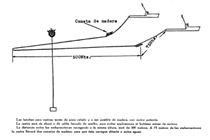 After the fall of Bilbao, the Basque minesweepers would help to sweep the minefields outside Santander. The Basque Navy provided the Republican Navy, at the beginning of July, a complete squadron consisting of 6 minesweepers and 2 auxiliary motor boats. The outstanding results meant that the Republican Navy decided to incorporate the vessels to its forces from 1st August. On that day, the Basque Navy delivered the 8 vessels that had swept Santander to the Cantabrian Sea Naval Forces. When Santander was evacuated, the majority of the minesweepers left for France on 24th August and arrived at La Pallice on the following day. Only the L-1, L-3 and the D-9, D-21 and D-22 would go to Asturias and continue their tasks to Gijón and Avilés until October. When Asturias fell, they fled to Bordeaux and Arcachon. Once the war was over, all the vessels would be returned to their owners.
After the fall of Bilbao, the Basque minesweepers would help to sweep the minefields outside Santander. The Basque Navy provided the Republican Navy, at the beginning of July, a complete squadron consisting of 6 minesweepers and 2 auxiliary motor boats. The outstanding results meant that the Republican Navy decided to incorporate the vessels to its forces from 1st August. On that day, the Basque Navy delivered the 8 vessels that had swept Santander to the Cantabrian Sea Naval Forces. When Santander was evacuated, the majority of the minesweepers left for France on 24th August and arrived at La Pallice on the following day. Only the L-1, L-3 and the D-9, D-21 and D-22 would go to Asturias and continue their tasks to Gijón and Avilés until October. When Asturias fell, they fled to Bordeaux and Arcachon. Once the war was over, all the vessels would be returned to their owners.
| Barrier | Discovered | Swept | Myne type | Neutralized mines | Total | |
|---|---|---|---|---|---|---|
| Recovered | Exploded | |||||
| Avilés(1º) | 13-1-37 | 2-2-37 | Vickers | 13 | 4 | 17 |
| Anti-sweeping devices | 1 | 1 | ||||
| Avilés(2º) | 10-2-37 | ? | Vickers | ? | ? | ? |
| Anti-sweeping devices | ? | ? | ? | |||
| El Musel(1º) | 10-2-37 | 15-3-37 | Vickers | 3 | 3 | |
| Santander | 2-4-37 | 30-5-37 | EME | 14 | 12 | 26 |
| Anti-sweeping devices | 8 | 8 | ||||
| El Musel(2º) | 2-5-37 | Julio-37 | EME | 36 | 36 | |
| Anti-sweeping devices | 10 | 10 | ||||
| Cabo Mayor | 4-7-37 | 10-7-37 | Vickers | 5 | 1 | 6 |
| Galizano | 12-7-37 | 24-7-37 | Vickers | 7 | 4 | 11 |
| Gijón-Aviles | 16-7-37 | October-37 | Carbonit | 14 | 14 | |
| Total neutralized mines | 111 | 21 | 132 | |||
